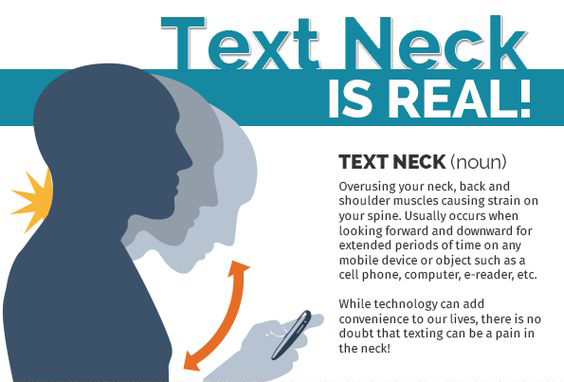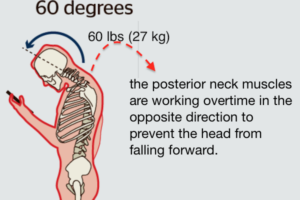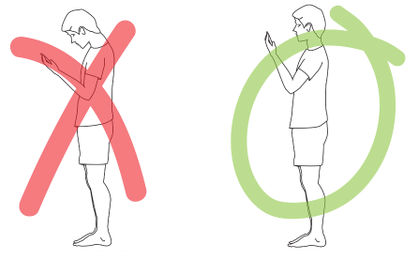nalco group
bone, muscle & joint pain physio
BOOK NOW / WHATSAPP ABOUT YOUR PAIN OR INJURY
- NOVENA 10 Sinaran Drive, Novena Medical Center #10-09, Singapore 307506
- TAMPINES 9 Tampines Grande #01-20 Singapore 528735
- SERANGOON 265 Serangoon Central Drive #04-269 Singapore 550265
Home > Blog > Physiotherapy > Conditions > Repetitive Strain Injuries > Neck Pain > How Does Text Neck Cause Pain?
How Does Text Neck Cause Pain?

Text neck refers specificly to a repetitive stress injury or overuse syndrome in the neck, which is typically caused by prolonged use of mobile devices with the head bent downward and not really or particularly moving much for a prolonged time, repeatedly.
Also called
- tech neck
- iNeck
- iPhone neck
text neck is usually associated with texting, but it can be related to many activities performed on phones and tablets while looking downward, such as
- browsing the web
- playing mobile games
- reading comics/news/text
- or doing work
Head’s Weight Magnified
The weight of the head is a key factor for text neck pain.
Our neck’s muscles, tendons, and ligaments are created to support our head’s weight, which is about 5 kilograms (kg), which translates to about 10 to 12 pounds in a neutral position balanced atop the cervical spine.
However, whenever we use our phones, it is so unfortunately common to bend the head forward
and look down at a 45- or 60-degree angle, which places about 50 to 60
pounds of force on the neck.

Our neck is not able to withstand this amount of pressure over a prolonged period - it's not made for that.
Our heads are meant to rest/sit on our shoulders, and the poor posture really strains our neck muscles terribly.
If not treated with spinal physiotherapy and phone postures corrected, next neck and neck pain may become worse.
Related Article: How Poor Posture Causes Neck Pain
how text neck develops and progresses
Text neck typically starts as a relatively "safe" mild ache in the neck or upper back. In some cases, it could also start with/as sharp pain or stiffness in the neck.
When text neck is suspected of causing pain, it is typically treated with a combination of:
- Changing phone or tablet use to necessary tasks
- Using better posture by holding devices up closer to eye level
- Spinal and neck physiotherapy
If your neck pain or text neck is not treated or improved, the continued forward head posture and hunched shoulders will worsen over time, which will lead to even more pain and reduced mobility in the neck, upper back, and shoulders.
In some cases, the excessive anterior forward head posture may exacerbate or accelerate degenerative conditions in the cervical spine (neck bones), such as
- cervical degenerative disc disease and/or
- cervical osteoarthritis
Unique Risks of Smartphones and Tablets to Stress the Neck
Here are some reasons why smartphone and tablet use may pose some unique risks to stress the spine:
- Severe neck angle to view the screen.
Compared to TVs and personal computers which tends to be placed at a further (and better viewing angle/distance), smartphone and tablet screens are more commonly viewed while flat on a table or lap, which means the screen angle is much more severe.
That's why it causes us to crane and "reach forward" our neck and head to view smartphones than other screens. - Touchscreen element may bring shoulders and head further forward.
Research in the Ergonomics journal found that study participants had more forward head posture while texting compared to other smartphone tasks, such as web browsing or watching a video.
Maybe because texting may involve the use of both hands as well as increased time with fingers touching/tapping the screen, which possibly recruits the muscles of the forearm, arms, shoulders that "pull" forward during use (especially when engrossed).
Yes, there are some other activities, such as reading a printed paper book or washing dishes, which also triggers and prompt people to forward tilt their heads, but the difference may be that people use smartphones and tablets for a much longer time and are less likely to shift positions.
(We don't typically wash dishes that long, and also washing dishes require us to move about...unless one works as a washerperson who washes dishes 6-10 hours a day)

Impact on Growing Spines Still Being Studied
There is especially special concern about the potential health impact on teenagers— who are among the most frequent text message users—whose spines are still developing.
Many doctors, spinal physiotherapists, chiropractors, and other medical
professionals have reported seeing an increase in neck pain and poor
posture among teenage patients due to frequent texting and mobile device
use, even in our Phoenix physio clinics.
Yes, while we recognize and realize that holding the head forward for long periods of time is a risk factor for neck pain, there is some debate as to how much of a factor smartphone and tablet use plays in neck pain and poor posture in teens and young adults.
While a study of young adults in Sweden found a link between texting time and neck pain, the results appeared stronger in the short-term rather than the long-term.
That being said, there was a study in Brazil that studied 18- to 21-year-olds that did not find a correlation between texting and neck pain.
We definitely need a lot more research to accurately pinpoint and determine the long-term impact that texting and mobile device use might have on neck health.
Text Neck Symptoms and Diagnosis
Text neck is not an official medical diagnosis (and jokingly also called iNeck or iPhone neck), but rather a term commonly used for a repetitive stress injury where excessive texting or mobile device use is believed to be the primary cause.
A doctor and our senior spinal physiotherapists typically identifies patients text neck pain after a physical exam and patient history are taken, including reviewing the symptoms.
Common Symptoms Associated with Text Neck
ext neck symptoms commonly include one or more of the following:
- Pain in the neck, upper back, and/or shoulder
This pain may be limited or localized to one specific spot and may feel intense or stabbing, or it may be a general ache and soreness that covers a broader region, such as spanning from the bottom of the neck and into the shoulder(s).
Related Article: Neck Pain & Shoulder Pain - Forward head posture and rounded shoulders
Our muscles in the neck, chest, and upper back can become overstrained, deconditioned and imbalanced due to repeated damage from prolonged forward head posture. This particular deconditioning can make it difficult to maintain good posture with the ears directly over the shoulders. - Reduced mobility
The neck, upper back, and shoulders will gradually become tighter, stiffer with overall decrease range of motion and painful at end range movement. - Headache
Muscles at the base of the neck can tighten or even go into spasm and become painful, or pain could also be referred from the neck up into the head (from myofascial trigger points due to poor posture).
Excessive amounts of time looking at screens, regardless of posture, may also increase the risk for eyestrain and headache - Increased pain when neck flexion.
Text neck symptoms tend to worsen when the neck is flexed forward into the position that originally caused the problem, such as while looking down and texting.
Where and how pain is felt can vary from case to case and patient to patient.
As an example,
- a patient who mainly looks at a phone screen while using both hands (or
no hands if it is lying on a table or lap) may be more susceptible to
having pain evenly "balanced pain" distributed on both sides of the neck and/or upper
back, as compared to
- someone who uses one hand may have more pain on one side due to using or straining those muscles more (one sided pain, or pain more on one side more than the other)
Less Common Symptoms Associated with Text Neck
Some other symptoms where the prolonged forward head tilting of text neck may play a contributing role include:
- Cervical radiculopathy
Symptoms of electric shock-like pain, pins-and-needles tingling, numbness, and/or weakness may radiate from the neck down into the shoulder, arm, and/or hand.
Cervical radiculopathy can happen when a cervical nerve root becomes irritated or compressed, such as from spinal changes related to degenerative disc disease or osteoarthritis. Severe cases of text neck may accelerate or worsen this process.
Related Article: Cervical radiculopathy - Balance issues
Prolonged amounts of time in forward head posture have been linked to reduced balance control and balance problems, due to the head’s center of gravity moving unnaturally further in front of the body.
This process will result in muscle imbalances and postural control changes in the neck and torso. - Jaw pain
A misalignment in the cervical spine and/or muscle imbalances may lead to jaw pain, or temporomandibular joint (TMJ) pain.
Other symptoms may also be associated with text neck.
Patient History and Physical Examination
When visiting the doctor with a primary complaint of neck pain, typically the first 2 steps involve:
- Patient history
The patient’s medical history, family health history, exercise and diet habits, medications, as well as current symptoms (and when they started) are reviewed. - Physical examination
The neck is observed for any unusual posture or lesions, and palpated for possible areas of muscle tightness or tenderness.
The patient's head may also be gently guided through various ranges of motion to see if specific neck movements are restricted or alter the pain response (improve, worsen, or no change).

If the patient's neck pain and/or neck stiffness is mainly due to a repetitive stress injury, such as text neck or tech neck, our senior spinal physiotherapists will do an in-depth assessment so that enough information is obtained through a careful patient history and physical exam to make a diagnosis and start spinal physiotherapy treatment.
If more serious causes of neck pain are suspected during the patient history and physical exam—such as nerve root compression (such as slipped disc and sciatica), fracture, or a serious underlying medical condition—imaging (x-ray or MRI) and other tests may be required.
Adjustments to Prevent Text Neck Pain

- Raise your tablet or phone
Bring your phone (and any other mobile or viewing devices) up closer to eye level so that your eyes or head does not have to be tilted forward. - Take frequent breaks (even short micro-breaks can help)
Try to spend some time away from the phone—or any type of head-forward posture regularly. If needed, set an alarm or app to set automatic reminders to take breaks from handheld devices. - Stand up straight
Good posture, with your chin tucked in and shoulders pulled back, will help to keep and protect the body when it is aligned in a neutral position. - Arch and stretch
Arch your neck and upper back backward regularly to improve blood flow, improve recovery and even ease any aches and muscle pain. - Exercise regularly
A strong, flexible back and neck is 100% more able to handle extra stress and load. Research indicates that teenagers who are active in low-impact team sports or endurance sports are less likely to have neck pain.
In general, finding ways to keep the neck and body more active, rather than hunched over a mobile device, is best for the spine.
Exercises and Stretches to Reduce Neck Pain
With text neck and other conditions related to forward head posture, muscle imbalances usually develop like this:
- The deep cervical flexor muscles at the front of the neck become overly stretched and elongated while the muscles connected to the head at the back of the neck become tightened and shortened
- The upper back muscles become elongated while the chest muscles become shortened
Some evidence also suggests that performing exercises and stretches in a school setting can help improve posture.
There was one specific study that looked at 130 teenagers with forward head and protracted shoulder posture. Half of the students (65) were enrolled in a physical education class that also included exercises and stretches designed to correct postural muscle imbalances. After 16 weeks, the students in the class with targeted exercises had more improvements in both neck and shoulder posture compared to the other students.
As an general guide or rule of thumb, regularly engaging in exercise that teaches posture and body awareness is an excellent way to counteract the tendency of developing neck pain from poor posture.
Examples of such exercise programs include
- yoga
- Pilates
- Alexander Technique
- etc
text neck spinal physiotherapy
Text neck spinal physiotherapy treatments may include:
- hands on manipulation and mobilization (manual therapy)
- computerized decompression spinal traction physiotherapy
- soft tissue management
- cold therapy
- hot pack and hot treatment to relief tight muscles and joints
- ultrasound therapy to accelerate soft tissue healing
- exercise therapy
- acupuncture or dry needling
- deep tissue release
- and more
If
you find that you have any back or neck pain, be it recently or have
been experiencing it for some time already; or know someone who does, do
consider seeing our specialist spine physiotherapist. You may even
prevent the need for back or neck surgery by early spinal physiotherapy
intervention.
Do not hesitate or wait for it to go away - pain is a normal response by our bodies to signal to us that there is some issues to resolve, and the earlier it's resolved, the faster it'd be resolved. When/if one delays on it, it may become worsen/progress into something more serious that may take much more time to resolve.
